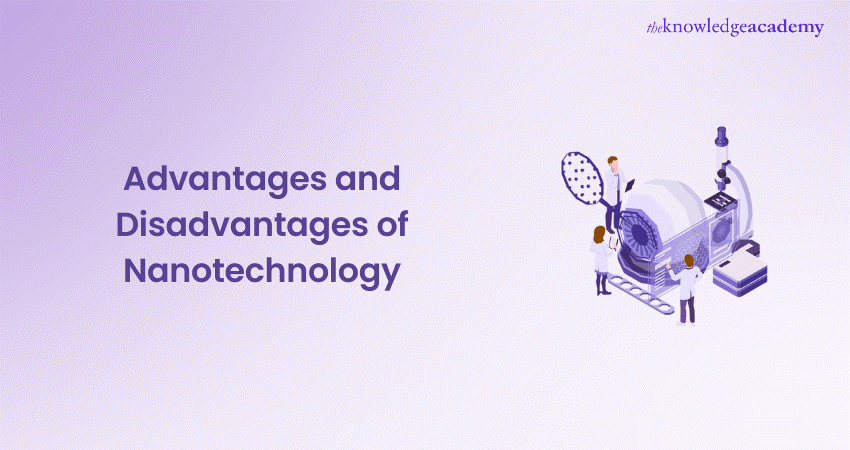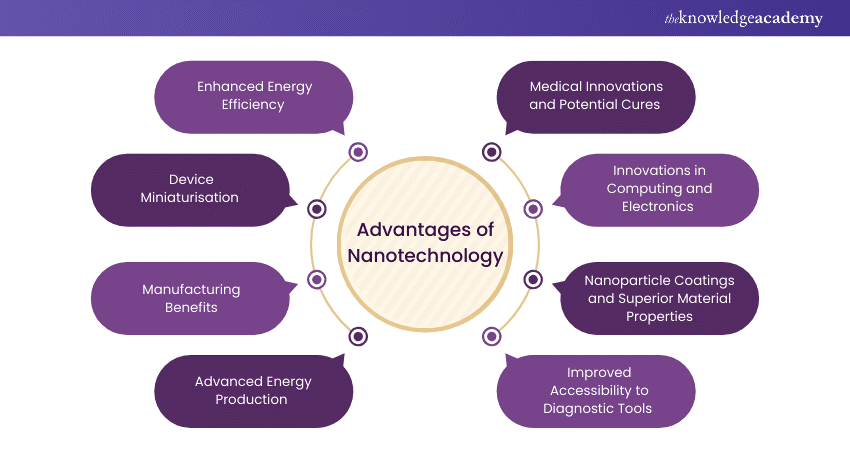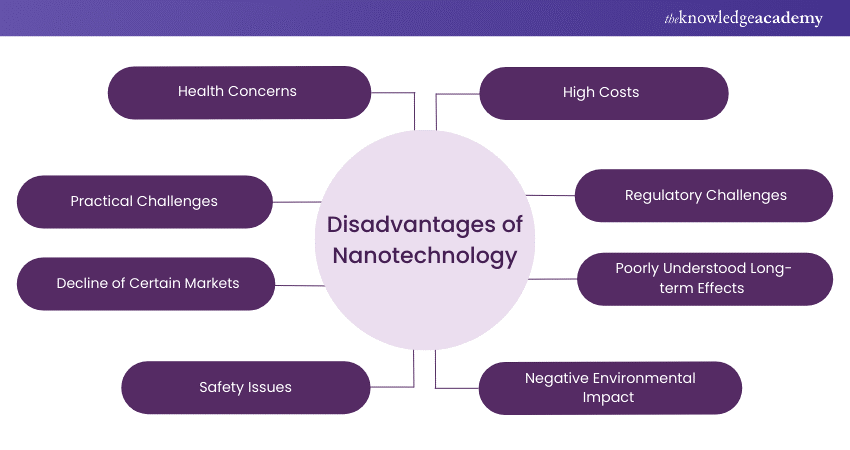We may not have the course you’re looking for. If you enquire or give us a call on +44 1344 203 999 and speak to our training experts, we may still be able to help with your training requirements.
Training Outcomes Within Your Budget!
We ensure quality, budget-alignment, and timely delivery by our expert instructors.

Are you fascinated by the potential of Nanotechnology to revolutionise our world? Imagine creating materials stronger than steel yet lighter than plastic or developing medical treatments that target diseases with pinpoint accuracy. This isn’t just science fiction; it’s the incredible promise of Nanotechnology. This blog will provide a comprehensive overview of the Advantages and Disadvantages of Nanotechnology.
Curious about how Nanotechnology could shape the future? We’ve got you covered. Whether you're thrilled by medical breakthroughs or concerned about ethical issues, understanding the Advantages and Disadvantages of Nanotechnology is essential. So, let’s embark on this journey to uncover the true potential and challenges of this tiny yet mighty technology.
Table of Contents
1) What is Nanotechnology?
2) Advantages of Nanotechnology
a) Enhanced Energy Efficiency
b) Device Miniaturisation
c) Manufacturing Benefits
d) Advanced Energy Production
e) Medical Innovations and Potential Cures
f) Innovations in Computing and Electronics
g) Nanoparticle Coatings and Superior Material Properties
h) Improved Accessibility to Diagnostic Tools
3) Disadvantages of Nanotechnology
4) Conclusion
What is Nanotechnology?
Nanotechnology is an innovative branch of science and engineering dedicated to the creation, production, and application of structures, devices, and systems by controlling matter on the atomic and molecular scale. A nanometre (nm) is one-billionth of a meter, approximately 100,000 times finer than a human hair.
This field exploits the distinctive properties found at the nanoscale, which are absent at macro scales, presenting extraordinary possibilities in numerous sectors. Nanotechnology is set to transform a variety of industries, from healthcare to electronics, by facilitating advancements that were once beyond our imagination.
Advantages of Nanotechnology
Nanotechnology offers a multitude of benefits across various fields, pushing the boundaries of what’s possible and revolutionising industries with its innovative applications. Let's explore the remarkable advantages this cutting-edge technology brings to the table.

1) Enhanced Energy Efficiency
Nanotechnology has revolutionised energy efficiency in numerous sectors. Nanomaterials can create more efficient solar cells, energy storage systems, and fuel cells. For instance, nanoparticles can improve the surface area of electrodes in batteries, leading to higher energy storage capacities and faster charging times.
2) Device Miniaturisation
One of the most significant advantages of Nanotechnology is the miniaturisation of electronic devices. This technology allows for the formation of smaller, faster, and more efficient components. Smartphones, computers, and other gadgets continue to shrink in size while increasing in power and functionality, thanks to nanotech advancements.
3) Manufacturing Benefits
Nanotechnology makes the way we make things better and cheaper. Materials made with nanotech are stronger, lighter, and last longer than normal materials. This means products work better and don’t need to be replaced or fixed as often.
4) Advanced Energy Production
Nanotechnology is very important for making new ways to produce energy. It’s used to make solar panels and wind turbines that work better. These help us get more energy from the sun and wind, which means we can use less oil and gas.
5) Medical Innovations and Potential Cures
Nanotechnology could change how we prevent and treat diseases. Tiny particles can carry medicine right to the cells that need it, which means it works better and doesn’t hurt other parts of the body. This is really helpful for treating serious illnesses like cancer because it targets the bad cells without harming the good ones.
6) Innovations in Computing and Electronics
Nanotechnology has spurred significant innovations in computing and electronics. Quantum dots, nanowires, and other nanomaterials are paving the way for the next generation of computers and electronic devices. These advancements promise increased processing speeds, greater storage capacities, and enhanced overall performance.
Explore the applications of Nanotechnology with our Nanotechnology Training!
7) Nanoparticle Coatings and Superior Material Properties
Nanoparticle coatings provide superior protection and functionality to various surfaces. These coatings can make materials more resistant to scratches, water, and other environmental factors.
Additionally, materials engineered at the nanoscale exhibit superior properties compared to traditional materials. They can be stronger, lighter, and more flexible, making them ideal for various applications, from aerospace to consumer electronics.
8) Improved Accessibility to Diagnostic Tools
Nanotechnology has improved accessibility to advanced diagnostic tools. Nanosensors can detect diseases at early stages, allowing for prompt treatment and better patient outcomes. These tools are increasingly used in point-of-care diagnostics, making healthcare more accessible and effective.
Gain proficiency in Reverse Engineering methods - register today for comprehensive Reverse Engineering Training and practical insights!
Disadvantages of Nanotechnology
While Nanotechnology presents numerous benefits, it also comes with its share of challenges and risks. It's important to consider these disadvantages to fully understand the complexities and implications of this advanced technology.

1) Health Concerns
Nanotechnology, while beneficial, poses health risks. Nanoparticles are so tiny that they can enter our bodies by being breathed in, swallowed, or through skin contact. Inside the body, they might interact with cells in ways we don’t fully understand, which could cause health problems.
2) Practical Challenges
Scaling up Nanotechnology comes with its own set of hurdles. Creating and handling materials at the nanoscale needs advanced tools and know-how, which makes it hard to keep things consistent and reliable when making lots of them.
3) Decline of Certain Markets
The progress in Nanotechnology might cause some markets to shrink. For example, industries that use old ways of making things might not be able to keep up with products made using nanotech. This could lead to economic shifts and job losses in those areas.
4) Safety Issues
There are big safety concerns with Nanotechnology. Nanomaterials could be risky to make, use, and throw away. It’s very important to handle and manage these materials safely to avoid accidents and harm to the environment.
5) High Costs
The money needed for Nanotechnology research, development, and putting it to use can be quite high. Even though the benefits might be more in the long run, the initial costs can stop many companies and industries from using it.
6) Regulatory Challenges
Regulating Nanotechnology is complex due to its multidisciplinary nature and rapid advancements. Developing appropriate regulations and standards to ensure safety and efficacy while fostering innovation is a challenging task for policymakers.
7) Poorly Understood Long-term Effects
The long-term effects of Nanotechnology are still poorly understood. The novelty of this technology means there is limited data on its long-term impact on health, the environment, and society. Continued research is essential to address these uncertainties.
8) Negative Environmental Impact
Nanotechnology can have a negative environmental impact if not managed properly. The production and disposal of nanomaterials can lead to pollution and ecological harm. Strategies to mitigate these risks are necessary to ensure environmental sustainability.
9) Decrease in Employment Opportunities
Automation and efficiency improvements driven by Nanotechnology can lead to a decline in job opportunities in certain sectors. As industries adopt more advanced technologies, the demand for traditional labour may decline, necessitating workforce retraining and adaptation.
10) Economic Disparities
Nanotechnology can exacerbate economic disparities. Wealthier nations and organisations with greater resources can invest in and benefit from nanotech advancements, potentially widening the gap between rich and poor. Ensuring equitable access to these technologies is essential to prevent further inequality.
Enhance your skills with Internet Of Things IoT Systems and Applications Training – sign up now for expert guidance!
Conclusion
Nanotechnology opens doors to astonishing innovations, from boosting energy efficiency to transforming medical treatments. Yet, it brings challenges like health risks and ethical dilemmas. Grasping the Advantages and Disadvantages of Nanotechnology is crucial for unlocking its full potential while navigating its intricate landscape responsibly.
Dive into the world of Nanotechnology through our detailed Nanotechnology Training - join us today and expand your knowledge!
Frequently Asked Questions

Nanotechnology impacts human health by enabling precise drug delivery, early disease detection, and advanced medical treatments. It targets specific cells, reducing side effects and improving efficacy, but it also raises concerns about nanoparticle exposure risks.

No, Nanotechnology is not a form of robotics. While both involve advanced technology, Nanotechnology focuses on altering materials at the atomic and molecular levels. Robotics, on the other hand, deals with designing and operating robots for various tasks.

The Knowledge Academy takes global learning to new heights, offering over 30,000 online courses across 490+ locations in 220 countries. This expansive reach ensures accessibility and convenience for learners worldwide.
Alongside our diverse Online Course Catalogue, encompassing 17 major categories, we go the extra mile by providing a plethora of free educational Online Resources like News updates, Blogs, videos, webinars, and interview questions. Tailoring learning experiences further, professionals can maximise value with customisable Course Bundles of TKA.

The Knowledge Academy’s Knowledge Pass, a prepaid voucher, adds another layer of flexibility, allowing course bookings over a 12-month period. Join us on a journey where education knows no bounds.

The Knowledge Academy offers various Advanced Technologies Courses, including Nanotechnology Training, Reverse Engineering Training, and Internet of Things IoT Systems and Applications Training. These courses cater to different skill levels, providing comprehensive insights into Reverse Engineering.
Our Advanced Technology Blogs cover a range of topics related to Nanotechnology, offering valuable resources, best practices, and industry insights. Whether you are a beginner or looking to advance your Advanced Technology skills, The Knowledge Academy's diverse courses and informative blogs have got you covered.
Upcoming Advanced Technology Resources Batches & Dates
Date
 Nano Technology Training
Nano Technology Training
Fri 6th Dec 2024
Fri 7th Feb 2025
Fri 4th Apr 2025
Fri 6th Jun 2025
Fri 8th Aug 2025
Fri 3rd Oct 2025
Fri 5th Dec 2025
 Halloween sale! Upto 40% off - 95 Vouchers Left
Halloween sale! Upto 40% off - 95 Vouchers Left







 Top Rated Course
Top Rated Course



 If you wish to make any changes to your course, please
If you wish to make any changes to your course, please


